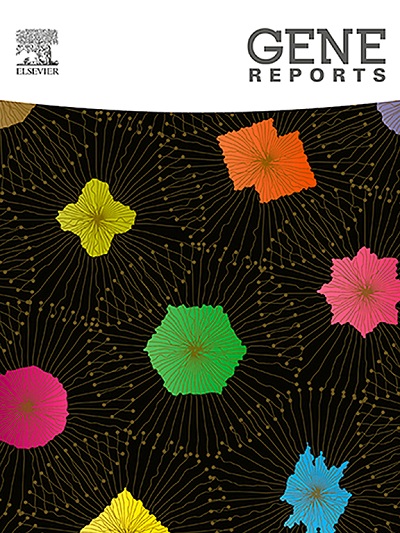Profiling of biomarker gene expression pattern in upper GI cancer in southern India
IF 0.9
Q4 GENETICS & HEREDITY
引用次数: 0
Abstract
Upper gastrointestinal (GI) cancers, including esophageal (EC) and gastric (GC), are highly lethal due to late diagnosis and limited biomarker-driven treatments. This study aimed to assess the expression profiles of selected cancer-associated genes E-cadherin, EGFR, HER2, Ki67, KIF2C, TP53, and PD-L1 in south Indian upper GI cancer patients using qRT-PCR. Gene expression patterns were analysed alongside clinical data and bacterial profiling. The study revealed the upper GI cancer subtype-specific variation in the gene expression pattern. In EC, E-cadherin was variably altered (−4.2 ± 2.3), while EGFR and HER2 showed overall downregulation with interpatient variability. Ki67 (3.4 ± 2.7), KIF2C (3.9 ± 2.9), TP53 (2.7 ± 2.4), and PD-L1 (2.7 ± 2.4) were generally upregulated, indicating enhanced proliferation, genomic instability, and immune modulation. Conversely, GC showed consistent downregulation of all seven genes, suggesting widespread transcriptional suppression and potential immune evasion. Correlation analysis revealed, Ki67-KIF2C and HER2-TP53-E-cadherin emerged as strongly co-expressed gene pairs, hinting coordinated tumor regulation mechanisms. ROC analysis highlighted KIF2C and TP53 as potential diagnostic markers, particularly in EC. Fecal bacterial analysis revealed increased diplococci, notably in GC patients. Clinicopathological correlations showed gene expression variations linked to age, diet, tumor site, and bowel habits. EC reflects active proliferation and immune interaction, whereas GC shows generalized gene suppression. KIF2C and TP53 could be potential diagnostic markers. Findings emphasize the value of integrated molecular and clinical profiling in advancing precision diagnostics for upper GI cancers. Further validation in larger, independent cohorts of multiple sites along with protein-level and functional studies is warranted to confirm the diagnostic utility and biological relevance of the identified biomarkers.

南印度上消化道肿瘤生物标志物基因表达谱分析
上消化道(GI)癌症,包括食管癌(EC)和胃癌(GC),由于诊断较晚和生物标志物驱动的治疗有限,是高度致命的。本研究旨在利用qRT-PCR技术评估南印度上消化道癌症患者中选定的癌症相关基因E-cadherin、EGFR、HER2、Ki67、KIF2C、TP53和PD-L1的表达谱。基因表达模式与临床数据和细菌谱一起分析。该研究揭示了上消化道肿瘤亚型特异性基因表达模式的变异。在EC中,E-cadherin发生了不同程度的改变(- 4.2±2.3),而EGFR和HER2呈整体下调,且存在患者间的差异。Ki67(3.4±2.7)、KIF2C(3.9±2.9)、TP53(2.7±2.4)和PD-L1(2.7±2.4)普遍上调,表明增殖增强、基因组不稳定和免疫调节。相反,GC显示所有7个基因一致下调,提示广泛的转录抑制和潜在的免疫逃避。相关分析显示,Ki67-KIF2C和HER2-TP53-E-cadherin是强共表达基因对,提示协同肿瘤调控机制。ROC分析强调KIF2C和TP53是潜在的诊断标志物,特别是在EC中。粪便细菌分析显示双球菌增加,特别是在胃癌患者中。临床病理相关性显示基因表达变异与年龄、饮食、肿瘤部位和排便习惯有关。EC反映了活跃的增殖和免疫相互作用,而GC则表现为普遍的基因抑制。KIF2C和TP53可能是潜在的诊断标志物。研究结果强调了综合分子和临床分析在推进上消化道癌症精确诊断中的价值。在更大的、独立的多位点队列以及蛋白质水平和功能研究中进一步验证是有必要的,以确认所鉴定的生物标志物的诊断效用和生物学相关性。
本文章由计算机程序翻译,如有差异,请以英文原文为准。
求助全文
约1分钟内获得全文
求助全文
来源期刊

Gene Reports
Biochemistry, Genetics and Molecular Biology-Genetics
CiteScore
3.30
自引率
7.70%
发文量
246
审稿时长
49 days
期刊介绍:
Gene Reports publishes papers that focus on the regulation, expression, function and evolution of genes in all biological contexts, including all prokaryotic and eukaryotic organisms, as well as viruses. Gene Reports strives to be a very diverse journal and topics in all fields will be considered for publication. Although not limited to the following, some general topics include: DNA Organization, Replication & Evolution -Focus on genomic DNA (chromosomal organization, comparative genomics, DNA replication, DNA repair, mobile DNA, mitochondrial DNA, chloroplast DNA). Expression & Function - Focus on functional RNAs (microRNAs, tRNAs, rRNAs, mRNA splicing, alternative polyadenylation) Regulation - Focus on processes that mediate gene-read out (epigenetics, chromatin, histone code, transcription, translation, protein degradation). Cell Signaling - Focus on mechanisms that control information flow into the nucleus to control gene expression (kinase and phosphatase pathways controlled by extra-cellular ligands, Wnt, Notch, TGFbeta/BMPs, FGFs, IGFs etc.) Profiling of gene expression and genetic variation - Focus on high throughput approaches (e.g., DeepSeq, ChIP-Seq, Affymetrix microarrays, proteomics) that define gene regulatory circuitry, molecular pathways and protein/protein networks. Genetics - Focus on development in model organisms (e.g., mouse, frog, fruit fly, worm), human genetic variation, population genetics, as well as agricultural and veterinary genetics. Molecular Pathology & Regenerative Medicine - Focus on the deregulation of molecular processes in human diseases and mechanisms supporting regeneration of tissues through pluripotent or multipotent stem cells.
 求助内容:
求助内容: 应助结果提醒方式:
应助结果提醒方式:


